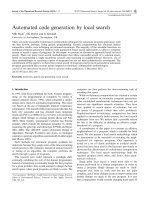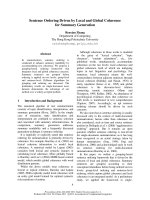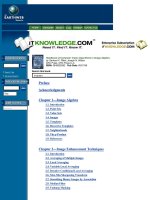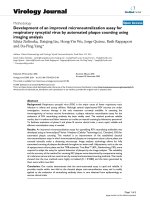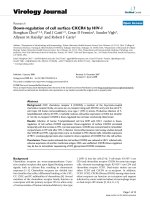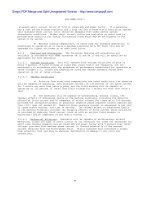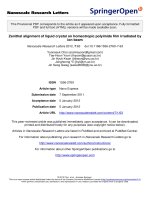Automated code generation by local search.pdf
Bạn đang xem bản rút gọn của tài liệu. Xem và tải ngay bản đầy đủ của tài liệu tại đây (779.6 KB, 17 trang )
Automated code generation by local search
MR Hyde
Ã
, EK Burke and G Kendall
University of Nottingham, Nottingham, UK
There are many successful evolutionary computation techniques for automatic program generation, with
the best known, perhaps, being genetic programming. Genetic programming has obtained human
competitive results, even infringing on patented inventions. The majority of the scientific literature on
automatic program generation employs such population-based search approaches, to allow a computer
system to search a space of programs. In this paper, we present an alternative approach based on local
search. There are many local search methodologies that allow successful search of a solution space,
based on maintaining a single incumbent solution and searching its neighbourhood. However, use of
these methodologies in searching a space of programs has not yet been systematically investigated. The
contribution of this paper is to show that a local search of programs can be more successful at automatic
program generation than current nature inspired evolutionary computation methodologies.
Journal of the Operational Research Society advance online publication, 5 December 2012;
doi:10.1057/jors.2012.149
Keywords: heuristics; genetic programming; local search
1. Introduction
In 1992, John Koza published his book ‘Genetic program-
ming: on the programming of computers by means of
natural selection’ (Koza, 1992), which presented a metho-
dology and a vision for automatic programming. This vision
was based on the use of biologically inspired evolutionary
computation. The research field created around this idea has
been very successful, and has obtained many important
results (see Poli et al (2008) for an overview), even producing
designs which infringe on existing patents (Koza and Poli,
2005). More recently, grammatical evolution has become
popular, which extends the biological metaphor by clearly
separating the genotype and phenotype (O’Neill and Ryan,
2001, 2003). The ‘ADATE’ system (Automatic Design of
Algorithms Through Evolution) also draws on biological
concepts to generate algorithms automatically (Løkketangen
and Olsson, 2010).
Such methods for automatic program synthesis are
important because they assign some of the time-consuming
search process to the computer. Instead of manual creation
or tuning of an algorithm, the computer performs the
search through a space of programs.
This research area could represent a paradigm shift,
eventually redefining the role of the human programmer.
Instead of attempting to manually design the best program
for a given problem, they would attempt to design the best
search space, where good programs are likely to exist. The
computer can then perform the time-consuming task of
searching that space.
While evolutionary computation has attained a certain
amount of success in automatic program generation,
other established metaheuristic techniques have not yet
received any significant research attention. They have
been applied to search spaces of solutions, but not
yet spaces of programs (which then solve problems).
Population-based evolutionary computation has been
applied to automatically build systems, but local search
techniques have not. We believe that a possible reason
for this is the difficulty in defining an effective neigh-
bourhood of a program.
A contribution of this paper is to present an effective
neighbourhood of a program, which is suitable for local
search. We also present a local search methodology which
we demonstrate to be successful at searching the neigh-
bourhood for superior programs. Our approach is
tested on a set of classic problems in artificial intelli-
gence that have been used in the literature previously to
showcase the effectiveness of evolutionary computation
techniques. The local search methodology finds the
required program more often, and faster, than gram-
matical evolution.
Single point local search is much more akin to the
process performed by a human programmer in order to
create a program. Single changes are made to ‘draft’
programs that seem to work well but are not quite
complete, and if those changes create an improvement then
further changes are made to the new program. It is rare
that a programmer would consider changing many parts of
Journal of the Operational Research Society (2012), 1–17
©
2012 Operational Research Society Ltd. All rights reserved. 0160-5682/12
www.palgrave-journals.com/jors/
Ã
Correspondence: MR Hyde, Tyndall Centre for Climate Change Research,
School of Environmental Sciences, University of East Anglia, Norwich,
NR4 7TJ, UK.
a program at once, which is the effect of the ‘crossover’
operator in grammatical evolution. This is because a
human programmer would usually wish to analyse the
effects of each individual change. Indeed, in many areas of
computer science (programming being a prime example), it
is considered good practice to only modify one element at a
time, in order to observe its effect.
Of course there are many successes of evolutionary
computation in the literature, and we are not suggesting
that local search will be superior to population-based
approaches in every case. We are suggesting that local
search should be researched in parallel with population-
based approaches in the pursuit of effective automatic
programming methodologies.
2. Related work
Because of the popularity of genetic programming as an
automatic programming methodology, this section consists
mainly of previous work from this area. We will not
explain genetic programming in detail in this paper, but we
point the reader to the following texts for good overviews;
Koza (1992), Banzhaf et al (1998), Koza and Poli (2005),
Poli et al (2008). Grammatical evolution (O’Neill and
Ryan, 2001, 2003) is a grammar-based form of genetic
programming. Because it is closely related to our local
search methodology, we explain it extensively in Section 4.
The ADATE (Automatic Design of Algorithms
Through Evolution) system (Olsson, 1995; Løkketangen
and Olsson, 2010) automatically generates code in a subset
of the programming language ML. The name of the
methodology implies a close similarity to genetic algorithms
and, indeed, it maintains a population of candidate
algorithms, and employs transformation operators which
could be described as ‘mutation’ operators. However,
ADATE is arguably more systematic in its search of
programs. For example, it is more successful at generating
recursive structures and iterative programs. Olsson (1995)
argues that, for recursive programs, the schema theorem
does not apply, and so it is unlikely that the standard
genetic programming crossover operator will be successful
at automatic generation of iterative and recursive programs.
A closely related area of research is ‘hyper-heuristics’,
which have been defined as heuristics which search a space
of heuristics, as opposed to a space of solutions (Burke et
al, 2003a, b; Ross, 2005). This research field has the goal of
automating the heuristic design process, and the metho-
dology presented in this paper could also be employed in
this way. Two classes of hyper-heuristic have been defined
by Burke et al (2010b). The first is the class that intel-
ligently chooses between complete functioning heuristics
which are supplied to it by the user. The second class of
hyper-heuristic automatically designs new heuristics, and
further information on this class can be found in Burke
et al (2009). The methodology presented in this paper
belongs to the second class of hyper-heuristic, to the extent
that the automatically generated code represents a heuristic
method.
Examples of hyper-heuristics of the second class include
systems which evolve local search heuristics for the SAT
problem (Bader-El-Den and Poli, 2007; Fukunaga, 2008).
Heuristic dispatching rules have also been evolved for the
job shop problem (Ho and Tay, 2005; Geiger et al, 2006;
Tay and Ho, 2008). Constructive heuristics for one
dimensional bin packing have been evolved by genetic
programming by Burke et al (2006, 2007a, b), showing that
evolved constructive bin packing heuristics can perform
better than the best-fit heuristic (Kenyon, 1996) on new
problems with the same piece size distribution as those on
which the heuristics were evolved (Burke et al, 2007a). The
results by Burke et al (2007b) show that the evolved
heuristics also maintain their performance on instances
with a much larger number of pieces than the training set.
It is also shown in Burke et al (2010a) that the evolved
heuristics can be further improved if the genetic program-
ming system can also use memory components with which
to build new heuristics.
The difference between human designed heuristics and
automatically designed heuristics for the three dimensional
packing problem is investigated by Allen et al (2009).
Hyper-heuristics can also evolve human competitive con-
structive heuristics for the two-dimensional strip packing
problem (Burke et al, 2010c). In that study, it is shown that
more general heuristics can be evolved, which are not
specialised to a given problem class.
A genetic algorithm is used to evolve hyper-heuristics for
the two-dimensional packing problem by Terashima-
Marin et al (2005, 2006, 2007, 2010). The evolved indi-
vidual contains criteria to decide which packing heuristic to
apply next, based on the properties of the pieces left to
pack. The genetic algorithm evolves a mapping from these
properties to an appropriate heuristic. The work follows
studies that evolve similar hyper-heuristics for the one-
dimensional bin packing problem (Ross et al, 2002, 2003),
in which the supplied local search heuristics have been
created by humans, and the task of the hyper-heuristic is to
decide under what circumstances it is best to apply each
heuristic.
As we mentioned in Section 1, evolutionary computation
is a common methodology for automatically generating
search algorithms and heuristics, and methodologies for
evolving evolutionary algorithms themselves are presented
by Oltean (2005), Diosan and Oltean (2009). Components
of existing heuristic methodologies can also be automati-
cally designed. For example, in Poli et al (2005a, b), the
particle velocity update rule is evolved for a particle swarm
algorithm.
The idea of comparing local search systems to population-
based approaches has previously been suggested by Juels and
2
Journal of the Operational Research Society
Wattenberg (1996). Our local search methodology comple-
ments and extends this work. In their paper, they present four
case studies, one of which relates to genetic programming.
They present a different neighbourhood move operator for
each case study. The genetic programming case employs a
neighbourhood move operator which relies on the ability of
any component to fit with any other component, and they
obtain very good results on the boolean multiplexer problem.
They state that this problem has the property that there is a
direct path to the optimum, through a series of states with
non-worsening fitness, and that this property helps the search
process. This is an important insight, and one which we
would argue is fundamental to the success of their algorithm.
Unfortunately it is a property which is not present in most
programming situations, because a grammar is usually
involved which restricts the connectivity of the components
and causes local optima. Therefore, to present local search
systems as viable alternatives to genetic programming,
they must incorporate the ability to utilise grammars.
This paper presents such a system, which is designed to
build programs from a grammar, rather than a special
case where any component can fit with any other. We
also show that our grammar-based neighbourhood move
operator can operate over a range of code generation
problems.
3. Problem domains
This section explains the problem domains that are
used in this paper to assess the performance of the local
search methodology. They are deliberately chosen as the
standard problem domains used to analyse the success of
evolutionary computation methodologies such as gram-
matical evolution (for example in O’Neill and Ryan,
2001, 2003).
3.1. Santa Fe ant trail
The Santa Fe ant trail problem is a standard control
problem in the genetic programming and grammatical
evolution literature. Its search space has been char-
acterised as ‘rugged with multiple plateaus split by deep
valleys and many local and global optima’ (Langdon
and Poli, 1998). It has been employed many times as a
benchmark to measure the effectiveness of evolutionary
computation techniques (Koza, 1992; O’Neill and
Ryan, 2001, 2003), and therefore it is an ideal problem
with which to assess the effectiveness of this local search
approach to automated programming, compared with
evolutionary approaches.
The problem is to find a control program for an artificial
ant, which traverses a toroidal 32 by 32 square grid. The
grid contains 89 predefined locations for food items, and
the ant must visit each of these locations. The ant has three
actions, ‘move’, ‘turn right’, and ‘turn left’. The ant has a
limit of 615 actions with which to visit all of the food
squares. It can also use a conditional test, which looks into
the square ahead and tests if it contains food. A map of the
ant trail is shown in Figure 1. The grammar used to create
the control programs is shown in Figure 4, as part of the
explanation of grammatical evolution.
3.2. Symbolic regression
Symbolic regression aims to find a function which succes-
sfully maps a set of input values onto their corresponding
target output values. The function examined is X
4
þ X
3
þ
X
2
þ X, and the range of the input values is [À1, þ 1]. The
grammar used to create the candidate functions is shown in
Figure 2. This is an intentionally simple grammar, from
which it should be easy to generate the correct code.
3.3. Even-5-parity
The even-5-parity problem aims to find a boolean
expression that evaluates to true when an even number
of its five inputs are true, and false when an odd number of
Figure 1 The Santa Fe ant trail grid. The ant begins in the
upper left corner. The food is black, and the ‘suggested’ ideal
route is included in grey. The grid is toroidal.
Figure 2 The grammar for symbolic regression.
MR Hyde et al—Automated code generation by local search
3
its inputs are true. The grammar employed in this study to
create the candidate functions is shown in Figure 3.
4. Grammatical evolution
Grammatical evolution (O’Neill and Ryan, 2001, 2003;
Dempsey et al, 2009) is explained here because our local
search code generator is based on the same grammar-based
process of generating code. However, our local search
methodology uses no evolution. It is based on searching
the neighbourhood of one individual, not on combining
elements from two ‘parent’ individuals. Grammatical
evolution is one of a number of grammar-based forms of
genetic programming, of which a survey can be found in
McKay et al (2010).
Grammatical evolution is an evolutionary computa-
tion methodology that generates sentences in an arbi-
trary language defined by a Backus-Naur form (BNF)
grammar. It evolves bit strings, as opposed to the
classical genetic programming approach of evolving tree
structures. The term ‘program’ is used in this section to
mean a functioning fragment of code which can perform
some task.
An example BNF grammar is shown in Figure 4. It
consists of a set of symbols, referred to as ‘non-terminals’,
which are shown to the left of the ‘:: ¼ ’ symbol on each line
of the grammar. To construct a sentence from the
grammar, the process begins with one non-terminal
symbol, and a set of production rules that define with
which sentences this non-terminal can be replaced. A
sentence can consist of the same non-terminal, other non-
terminals, and ‘terminals’.
Terminals are components of the final sentence, which
have no production rules because they are not subsequently
replaced. Usually, there is a set of more than one
production rule for each non-terminal, from which one
must be chosen. When the non-terminal is replaced with a
sentence, the non-terminals in the new sentence are each
replaced with one sentence. Each non-terminal has its own
set of production rules. When the sentence consists only of
terminals, then the process is complete.
Grammatical evolution differs from standard genetic
programming in that there is a clear separation between
genotype and phenotype. The genotype can be repre-
sented as a variable length bit string, consisting of a
number of ‘codons’, which are 8-bit sections of the
genome. So, the decimal value of each codon can be
between 0 and 255. This is the traditional grammatical
evolution genotype representation, but in the gramma-
tical evolution literature the genotype is now often
represented directly as a decimal integer string. It has
also been represented as a string of real valued codons in
the grammatical swarm system (O’Neill and Brabazon,
2006).
The strings represent programs, because they encode
a sequence of choices of production rules from the
grammar. This methodology is especially applicable for
generating code because the grammar can specify the
programming language syntax, so that every generated
program represents a valid section of code which can be
compiled.
Figure 5 shows an example bit string genotype. We can
see that it can be separated into 8-bit sections, which are
referred to as codons. These codons each represent an
integer value in the range [0, 255], and the specific integers
generated from our example bit string are also shown in
Figure 5. It is these integers which determine how a
program is generated from the grammar.
Figure 4 shows the grammar we will use for this
example, and Table 1 shows the process of generating a
sentence from that grammar using the string of integers in
Figure 5.
In Table 1, we can see that the generation process starts
with one symbol, in this case ‘/codeS’. From the
grammar, we see that there are two production rules for
this symbol: ‘/lineS’and‘/codeS/lineS’.
To make the choice between the two sentences, the first
integer from the string is taken to modulus 2 (for two
choices). This returns a value of 1, so the second option is
chosen, as they are indexed from zero. This sentence
replaces the original ‘/codeS’ symbol. This process can be
seen in step 1 in Table 1, and the result can be seen in the
current sentence of step 2.
We always replace the first available symbol in the
current sentence, so the next integer is applied to the new
Figure 3 The grammar for even-5-parity.
Figure 5 An example string, and its corresponding string of
integers used to generate a program from the grammar.
Figure 4 The grammar for the Santa Fe ant trail.
4
Journal of the Operational Research Society
‘/codeS’ symbol, which gets replaced by ‘/lineS’ in step
2. The process continues in the same way until there are no
non-terminal symbols to replace in the sentence.
There are two exceptions to this rule. The first is that in
step 4, the ‘/ifS’ symbol has only one choice of pro-
duction rule in the grammar, so that rule is immediately
applied without referring to the next integer. The second
is that we reach the last integer in the sequence in step 8,
at which point the so-called ‘wrapping’ mechanism
occursandwegobacktothefirstintegeragainforthe
next choice, in step 9.
Wrapping is convenient, as it ensures valid individuals,
but we argue that it does not contribute to a systematic
search of the space of programs. Each part of the string in
a good individual represents a set of choices, producing
part of a successful program. We would suggest that
including that part somewhere else in the same string (or in
another string, as with the so-called ‘crossover’ operator)
will change the original meaning of each integer value.
Each integer will make a different choice when it is put in
the new location, and so it will not create the same subtree
that made it part of a fit individual in the first place. The
results of this paper argue that there are more systematic
search methodologies that have yet to emerge for
automated programming.
The mechanism of generating a program from a
grammar with a sequence of integers is a key concept
used in our methodology, and so we have explained it as
fully as possible. The fact that each ‘codon’ (integer) in
the string defines a choice, from a pre-defined set of
production rules, is the inspiration for the system
presented in this paper, which searches the sequences
of choices in a more systematic way than is possible
through grammatical evolution.
5. Local search of programs
This section presents the local search methodology for
automated code generation from a grammar. In the
examples, the grammar for the Santa Fe ant trail is used.
The local search methodology aims to find a string of
integers which produces a fragment of code with the
desired functionality, from a predefined grammar. The
methodology is an iterative process by which a string’s
neighbourhood is systematically explored for a certain
number of evaluations, and if no improvement is found
then a new individual is generated at a different location in
the search space. As such, it is similar to the technique of
iterated local search (Baxter, 1981; Martin et al, 1992;
Lourenco et al, 2003). Our methodology also includes a
tabu list, which prevents fitness evaluations from being
wasted on evaluating programs that have previously been
evaluated.
This section is organised as follows. Section 5.1 explains
the process of generating a new integer string. Section 5.2
explains the process by which the neighbourhood search of
that string is started, and Section 5.3 describes how it
continues. Section 5.4 then explains when the search of the
neighbourhood is terminated. At this point a random new
individual is created (returning the process to the begin-
ning, at Section 5.1), or the process starts again from a
better string which is found in the neighbourhood
(returning the process to Section 5.2). This cycle is depicted
in Figure 6. The pseudocode of the algorithm is shown in
algorithm 1.
5.1. Initialising one string
This section explains the beginning of the search process,
including the method by which we generate a random
string to be the first ‘current’ string. The local search
methodology also returns to this point if no superior string
is found in the neighbourhood of the current string, so this
part of the process is often performed many times before
the end of a run.
The integer string represents a sequence of decisions of
which production rule to apply next, as described in
Section 4. Each integer is randomly chosen from the set
of valid choices available at the current production rule.
Figure 6 An overview of Section 5, the local search process.
Table 1 The process of generating a program from the
grammar, using the integers derived from the example bit string
of figure 5 (151, 60, 86, 25, 198, 39, 230)
Step Current sentence Choice made
1 /codeS 151 mod 2=1
2 /codeS/lineS 60 mod 2=0
3 /lineS/lineS 86 mod 2=0
4 /ifS/lineS
5 if (foodahead()) { /lineS }
else { /lineS } /lineS
25 mod 2=1
6 if (foodahead()) { /opS }
else { /lineS } /lineS
198 mod 3=0
7 if (foodahead()) { move(); }
else { /lineS } /lineS
39 mod 2=1
8 if (foodahead()) { move(); }
else { /opS } /lineS
230 mod 3=2
9 if (foodahead()) { move(); }
else { right(); } /lineS
151 mod 2=1
10 if (foodahead()) { move(); }
else { right(); } /opS
60 mod 3=0
11 if (foodahead()) { move(); }
else { right(); } move();
MR Hyde et al—Automated code generation by local search
5
The first integer in the string therefore represents the choice
of production rule for the start symbol /codeS, and can
only have a value of 0 or 1, as there are only two
production rules for /codeS.
Algorithm 1 The pseudocode for the local search algorithm
evals=0
newstring’TRUE
while evalsp23 000 do
if newstring=TRUE then
current_string’generate random string
end if
newstring’TRUE
l’length(current_string)
tabulists=new array (length l) of tabu lists
{begin neighbourhood search}
for j=1 to 3 do
for i=0 to l do
string s’modify(current_string,indexi)
if s is not in tabulists[i] then
evals’evals þ 1
add s to tabulists[i]
if s superior to best then
best’s
end if
else
i=iÀ
1
end if
end for
if best superior to current_string then
current_string’best
newstring’FALSE
break from loop
{we return to the beginning of the while loop}
end if
end for
end while
return best found string
Figure 7 shows the string from which we will begin the
example, and is typical of a string that would be created
randomly in the initialisation process. In contrast to a
genome in grammatical evolution, each integer corre-
sponds to exactly one choice, and the range of values that it
can take is limited by the number of options that are
available to choose from. Underneath each integer is the
particular non-terminal symbol from which the integer
chooses.
It may further clarify the process to visualise the string
representation as a tree representation, starting with the
root (in this case the /codeS symbol). Figure 8 shows
the tree structure which is generated by the individual in
Figure 6. At each non-terminal symbol in the tree, the
integer that makes the choice of production rule is shown
in brackets after the symbol. These integers correspond to
the integer sequence in Figure 6, applied in a ‘depth first’
order.
Algorithm 2 shows the valid program that is gen-
erated by the integer string from the grammar. One can
see that the final program consists of all of the non-
terminal symbols shown in the tree of Figure 8. This
program is evaluated on the Santa Fe ant trail problem,
to ascertain the fitness of the string that created it. We
find that it has a fitness of 4, as four food squares
are visited by the ant. This is a poorly performing
individual, as the maximum fitness is 89. Nevertheless,
the local search methodology will search its neighbourhood
Figure 7 An example integer string, as used in the local search
methodology presented in this paper. Each integer is linked to
the symbol that it chooses the production rule for.
Figure 8 The tree structure represented by the integer string in
Figure 6.
6
Journal of the Operational Research Society
